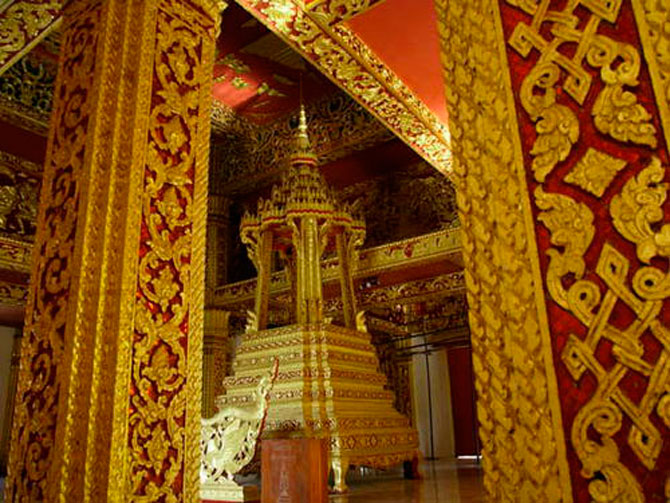Luang Prabang-Laos city
The United Nations Science, Education and Culture Organization recognized the Lao city of Luang Prabang as a World Cultural Heritage in 1995.
Luang Prabang City - World Cultural Heritage in Laos
Luang Prabang is a city with a long history, before 1975 it was still the royal couple, the center of the Kingdom of Laos. From Luang Prabang to Vientiane about 424 km, the city's population is 22,000 people.
The reason Luang Prabang is recognized by UNESCO as a world cultural heritage because of the unique historical value of this royal city, it witnessed the rule of 63 kings. Besides, the city is also a Buddhist center with thousands of temples, many of which are beautiful architectural highlights, painted with magnificent and mysterious gold-plated lipstick. Not only that, Luang Prabang is also a peaceful, charming small city nestled on the green and dreamy Mekong and Nam Khan rivers and surrounded by cloudy mountains all year round.

Located in the north of central Laos, where the small rivers with the Mekong River are surrounded by trees, which are the capital of the Lan Xang empire - the first kingdom of Laos (1350-1545). In the 16th century, although the capital was transferred to Vientiane, Luang Prabang preserved its position as the cradle of Laos' diverse culture. Luang Prabang is also a place to preserve the heritage of art and architecture : with over 30 magnificent palaces, most of them were built in the 14th century; about 40 ancient temples were built from different dynasties, each temple is a cultural work of high artistic value; Hundreds of old wooden houses are designed in a very beautiful style, arranged in orderly along the long small streets to create a beautiful and quiet look.

In Luang Prabang, architectural masterpieces like Wat Xiengthong - an ancient royal shrine built in 1560 and Wat May with 5-layer-thick roof tiles, are two of many beautiful tombs with detailed lines. architecture and great decorative details. Wat Xiengthong has rich wood carvings and decorations.
A fairly famous spot is Wat Visounarath temple . In the past the temple had many precious Buddha statues stored in the towers. Due to the time and the destruction of the weather, the towers have become ruined, the Buddha statues have been transferred to the Royal Palace museum, including the famous golden Buddha statue of Pra. Buddha State existed here during the period from 1513 to 1894.

Another sight is Wat Vixum , built in 1513 and then rebuilt in 1898. It worships the largest Buddha statue in Luang Prabang. In the same architectural complex, Ta Mak Mo is famous for its excellent hemispherical architecture. Here, visitors can climb 328 stairs of Phousi (stone blocks placed at the top of the temple in the center of Luang Prabang). The religious monuments here are very small but the shape is very beautiful. One of the city's roofs that you can see from above Phousi is the old royal tomb - the impressive cross in the combination of sophisticated architectural details of Laos and France. Now, these tombs have become museums with many precious artifacts.
Although Luang Prabang is a small city with only 22,000 inhabitants, Luang Prabang is Laos' most important tourist destination for foreigners. Recently, Luang Prabang has been named among the 10 most selected cities in 2007 voted by respected magazine Leisure Travel.










- Sa Pa, Hoi An and Ha Long are among the most beautiful scenes in Asia
- Tropical depressions are likely to become strong storms heading into the South China Sea
- The most spectacular natural swimming pools in the world
- Sao la is captured in Laos
- Experts call on Laos to abandon the hydroelectric dam
- Vietnam-Laos promotes scientific and technological cooperation
- Vietnam worries about salinity because of Laos hydroelectricity
- 3.2 magnitude earthquake in Vietnam-Laos border area
- Video: Elephants naturally cross the border before the inability of the Chinese border
- Mysterious fields jars in Laos
- How can the Thai team survive in the cave?
- China, Laos, and Thai built transnational bridges
 Suzhou classic bonsai garden - China
Suzhou classic bonsai garden - China Chau Nguyen Dynasty
Chau Nguyen Dynasty Thai Son Mountain - World Wonder
Thai Son Mountain - World Wonder Ancient villages of Shirakawa-go and Gokayama
Ancient villages of Shirakawa-go and Gokayama